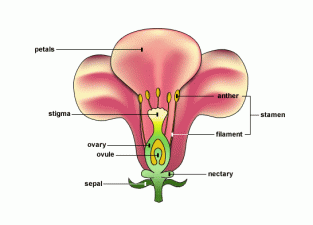
FLOWERS
Site of sexual Reproduction.
Male and female reproductive organs are borne on flowers.
PARTS OF A FLOWER:
Four whorls – calyx (sepals), corolla (petals), androecium (Male
reproductive organ), gynoecium (Female reproductive organs)
Function of calyx:protects the bud. Function of corolla :attracts insects by its colour
Male Reproductive Organ
Androecium consists of Stamens.
Stamen consists of anther, filament & connective (when anther is bilobed)
Anther bilobedhas 4 Microsporangia.
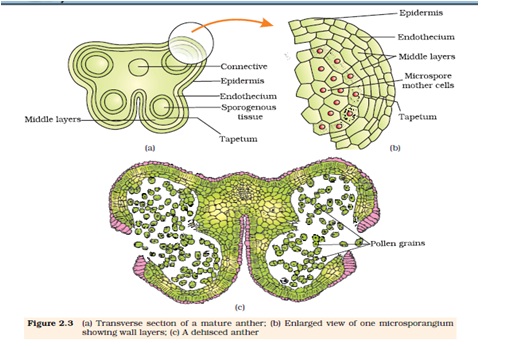
MICROSPOROGENESIS: The process of formation of micro spores from pollen mother cell through meiosis is called microsprogenesis.
Tapetum: Inner most layer of wall of microsporangium .Cells have dense cytoplasm. Generally have more than one nucleus .Nourishes the developing pollen grain
Microspore mother cell (2n) 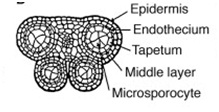
↓Meiosis
Microspore (n)
↓Mitosis
Pollen grains (n)
LAYERS OF ANTHER WALL
Pollen grains have two outer walls; i) Exine ii) Intine
Exine is made of sporopollenin.(Hardest natural substance). Intine is made of cellulose and pectin. Mature pollen grains have two cells – largevegetative cell & small generative cell.
Generative cell forms two male gametes by mitotic division.
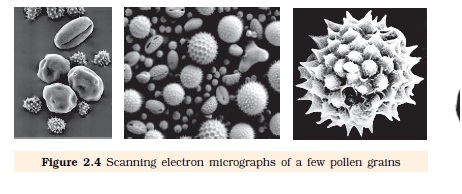
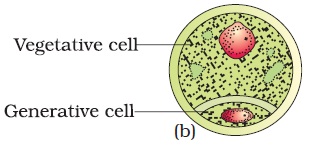
Gynoecium / carpel-The female reproductive organ
Megasporangium- Structure of anatropous ovule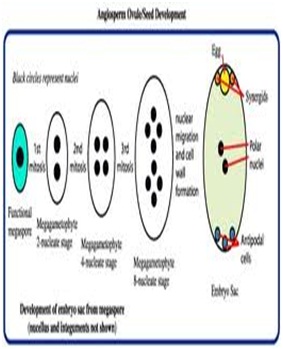
Each Carpel consists of ovary, style &stigma.
Ovules are attached to ovary by placenta.
Funicle – stalk of ovule
Hilum, a region where funicle is attached
Integuments –cover embryo sac.
Micropyle – a pore for entry of pollen tube & to imbibe water.
Anatropous ovule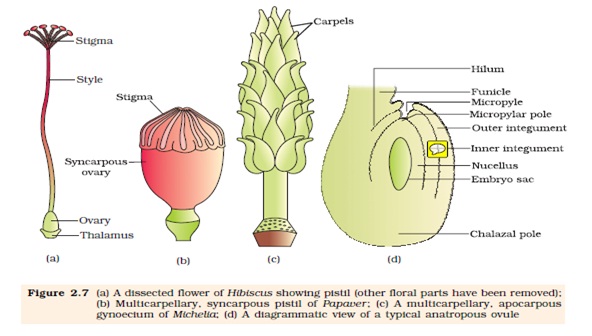
Megasporogenesis
Megaspore mother cell (2n)
Meiosis
4 Megaspores (n)
(3 megaspores degenerate, 1 remains functional)
Funtional Megaspore (n) (Divides 3times by mitosis)
8 Nucleated Embryo Sac formed
3 cells group at micropylar end -the egg cell(n) & 2 synergids(n)
3 cells at chalazal end called antipodals(n)
2 polar nuclei at center(n each )
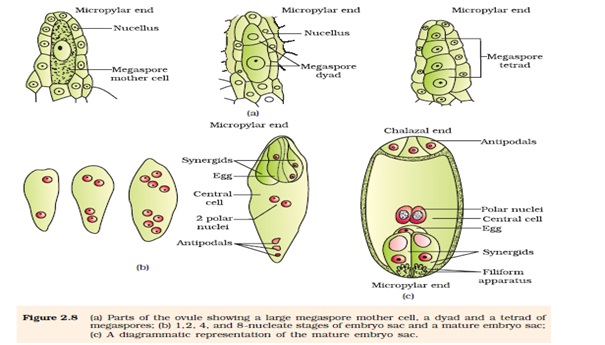
| Embryo sac |
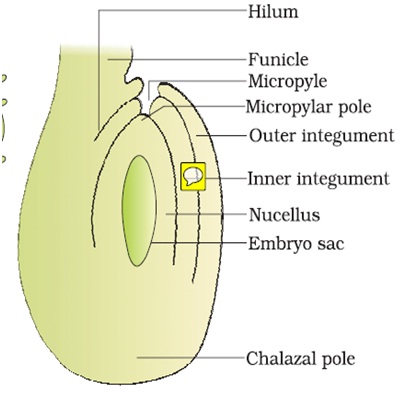
POLLINATION– Transfer of pollen from anther to stigma.
Agents of pollination –air, water, insect.bat,bird,man.
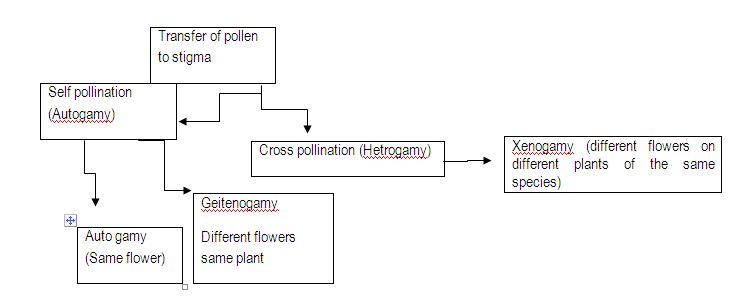
Pollen –pistil Interaction
- All the events from pollen deposition on the stigma until the entry of the pollen tube into the ovule are together called pollen-pistil interaction.
- It is a dynamic process involving pollen recognition by stigma/pistil for compatible pollen by accepting them and if incompatible rejecting them.
Double fertilization
Pollen grains germinate on stigma & pollen tube grows through style.
Pollen tube reaches micropyle& releases two male gametes into embryo-sac
Fertilisation is the process of fusion of male& female gametes (n+n) to form a diploid(2n)zygote.
Double fertilization: i)Fusion of male gamete with egg – First fertilization – SYNGAMY
ii) Fusion of fusion product of polar nuclei with male gamete – Second fertilization –TRIPLE FUSION
Outbreeding devices: Continued self-pollination result in breeding depression. Flowering plants have developed many devices to discourage self-pollination & encourage cross-pollination such as Bearing uni sexual flowers Uni sexuality
Anther & stigma mature at different times Dichogamy
Anther & stigma placed at different positions Heterostyly
Pollen grains of a flower do not germinate on the stigma of the same flower- Self incompatibility
Artificial Hybridization
Types of cross-pollination performed by man for crop improvement. Achieved by man.
- i) Emasculation i.e. removal of anthers from the flower bud of a bisexual flower before the anther dehisces using a pair of forceps and
- ii) Bagging i.e. covering the emasculated flowers with a bag of suitable size to protect them from contamination with unwanted pollen
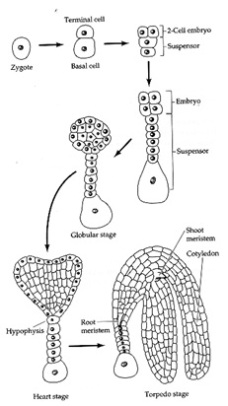
If flower is unisexual, emasculation is notneeded. Flower bud bagged & when the stigmabecomes receptive, pollination is done using desired pollen & the flower is re bagged.
Post fertilization changes:
Stages of embryo development after fertilization:
- Zygote divides by mitosis into suspensor & embryo cells
- Suspensor cell forms a globular basal cell which remains embedded in the endosperm & amulticellular suspensor bearing the embryo
3.Globular embryo becomes heart-shaped & then mature embryo with radicle, plumule & Cotyledons
Primary endosperm nucleus – divides repeatedly to form
endosperm, food for theembryo.
Mature ovary becomes fruit
Mature ovule becomes seed.
True Fruit develops only from the ovary, e.g. mango, tomato
False Fruit develops from parts of the flower other than the ovary e.g. apple, peach etc.
Seeds two types: i) Albuminous (with Endosperm)ii) Non albuminous(without Endosperm).
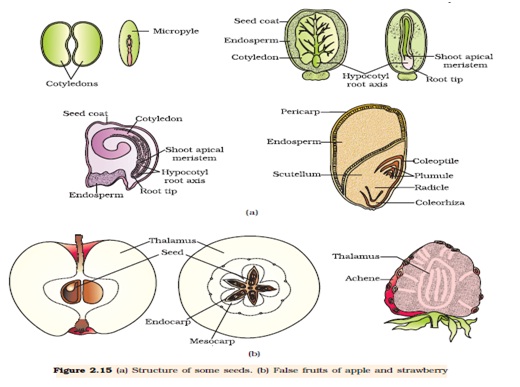
Special mechanism of reproduction:-
- Apomixis– Production of seeds without fertilization
e.g.species of Astereceae and grasses.
2. Polyembryony– Occurrence of more than one embryo in a seed. g.Orange.
*********************************************
CONCEPT MAP- SEXUAL REPRODUCTION IN FLOWERING PLANTS
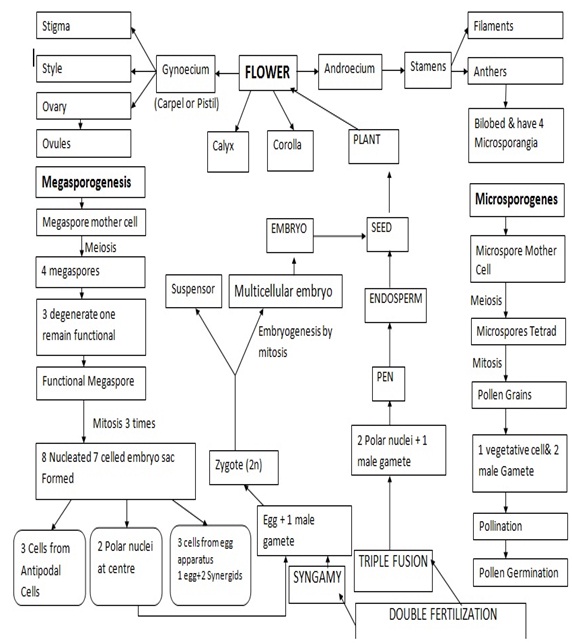
CHAPTER 2 – SEXUAL REPRODUCTION IN FLOWERING PLANTS – MILL QUESTIONS
1.Name the organic material exine of the pollen grain is made up of.How is this material advantage to pollen grain?
- Still it isobserved that it does not form a continuous layer around the pollen grain.Give reason.
- How are pollen banks useful?
2.How do the pollen grains of Vallisnaria protect themselves?
3. Gynaecium of a flower may be apocarpous or syncarpous.Explain with the help of an example each.
4.How does a farmer use the dormancy of seeds to his advantage? What advantages a seed provides to a plant?
5. (a). How are parthenocarpic fruits produced by some plants and apomictic seedsby some others? Explain.
(b). How do farmers prefer using apomictic seeds?
6.What is perisperm? Name two plants having perisperm.
7. Draw a labeled diagram of embryosac in angiosperms.Name the cell that develop into the embryosac and explain how this cell leads to the formationof Embryosac. Also mention the role played by the various cells of theembryosac.
8. Draw a labeled diagram of the sectional view of a mature pollen grain of angiosperms.Explain the function of any two of its parts.
9.State one advantage and one disadvantage of cleistogamy.
10. Why is fertilisation in an angiosperm referred to as double fertilization? Mention the ploidy of the cells involved.
11. Draw diagram of a section of a megasporangium of an angiosperm and labelfunicles, micropyle, embryosac and nucellus.
12.Name two types of flower present in plants commelina, Oxalis ,viola. Which of the two will produce assured seed set.
13. What is fili form apparatus? What is its function?
14. Explain the process of pollination in Vallisneria. How is it different in water lily, which is also an aquatic plant?
15.What is the speciality of Yuca plant pollination?
ANSWER KEY -MILL
1. (a). Sporopollinin .Is is highly resistant.
(b).Germ pores are present in the exine.
(c) Collection and storing of various types of pollen.
2. Pollen grains are protected from wetting by a mucilaginous covering.
3. Apocarpous-free carpels, Syncarpous-Fused carpels.
4. The dormancy of seed helps to overcome the unfavourable conditions.
5. Parthenocarpic fruits are formed without fertilization .Apomictic seeds are formed without fertilisation. Apomictic seeds reduce the variation.
6. The presence of nucellus cells in the seed is called perisperm. Ex-Black pepper, Beet.
7.
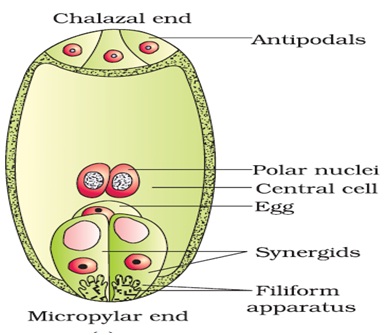
8.

9. Cleistogamous flowers produce assured seed-set even in the absence of pollinators. cleistogamyreduce variation.
- One of the male gametesmoves towards the egg cell and fuses with its nucleus thus completing thesyngamy. This results in the formation of a diploid cell, the zygote. The other male gamete moves towards the two polar nuclei located in the central cell and fuses with them to produce a triploid primary endosperm nucleus(PEN). As this involves the fusion of three haploid nuclei it is termed triple fusion. Since two types of fusions, syngamy and triple fusion take place in an embryo sac the phenomenon is termed double fertilization.
11.
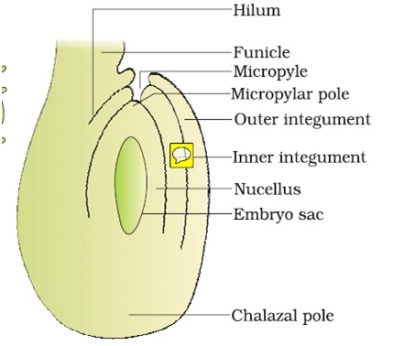
12. Plants such as Viola (common pansy), Oxalis, and Commelina produce two types of flowers –chasmogamous flowers which are similar to flowers of other species with exposed anthers and stigma, and cleistogamous flowers which do not open at all.
- The fili form apparatus present at the micropylarpart of the synergids guides the entry of pollen tube.
- water pollinated plants are Vallisneria use water for pollination. In water hyacinth and water lily, the flowers emerge above the level of water and are pollinated by insects or wind as in most of the land plants. In Vallisneria, the female flower reach the surface of water by the long stalk and the male flowers or pollen grains are released on to the surface of water. They are carried passively by water currents some of them eventually reach the female flowers and the stigma.
- A relationship exists between a species of moth and the plant Yucca where both species – moth and the plant – cannot complete their life cycles without each other. The moth deposits its eggs in the locule of the ovary and the flower, in turn, gets pollinated by the moth. The larvae of the moth come out of the eggs as the seeds start developing.
*************
HOT QUESTIONS
16.Differentiate between perisperm and endosperm giving one example of each.
17. Differentiate between micro sporogenesis and megasporogenesis? Which type of cell division during these events? Name the structures formed at the end of these two events.
18.Even though each pollen grain has two male gametes, why are at least 10 pollen grains and not 5 pollen grains required to fertilise 10 ovules present in a particular carpel?
19. Name all the haploid cells present in an unfertilized mature embryosac of a flowering plant. Write the total number of cells in it.
20. (a).Draw L.s of a pistil showing pollen tube entering the embryosac in an angiosperm and label any six parts other than stigma, style and ovary.
(b). Write the changes a fertilized ovule under goes within the ovary in an angiosperm plant.
21.With the help of diagrams, depict the stages of a microspore maturing into a pollen grain.
22.Describe the endosperm development in coconut. Why is tender coconut considered a healthy source of nutrition?
23. How are pea seeds different from castor seeds with respect to endosperm?
24.What are the out breeding devices seen in plants? What is its significance?
25.Give reason why
- Most zygotes in Angiosperms divide only after certain amount of Endosperm is formed.
- Ground nut seeds are non albuminous and Castor seeds are Albuminous.
- Micropyle remain as a small pore in seed coat of a seed.
- Integument of the ovule harden and the water content is highly reduced as the seed mature.
- Apple and Cashew are not called true fruits.
26. A pollen grain in an angiosperm at the time of dehiscence from an anther could be 2-celled or 3 -celled. Explain? How are the cells placed within the pollen grain when shed at a 2-celled stage?
27.Can a plant flowering in Chennai be pollinated by pollen grains of the same species growing in New Delhi? Provide explanations to your answer.
28.When a seed of Orange is squeezed, many embryos,instead of one are observed. Explain how it is possible. Are these embryos genetically similar or different? Comment.
29.Pollen grains in wheat are shed at 3-celled stage while in Peas they are shed at 2-celled stage. Explain. Where are germpores present in a pollen grain?
30. (a).Trace the development of an endosperm after fertilisation with reference to Coconut. mention the importance of endosperm development.
(b).Draw a neat sketch of L.S of an endospermous monocot seed.
**********************************************
